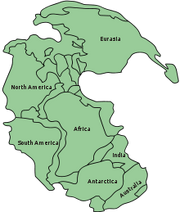The Mesozoic is an era of geologic time lasting from 252.2 to 66 million years ago.[1] It is often called the "Age of Reptiles" because dinosaurs were the dominant animals during this era.
Geologic periods[]
The Mesozoic was separated into three geologic periods. From oldest to youngest they were:
- Triassic (252.2 - 201.3 mya)
- Jurassic (201.3 - 145 mya)
- Cretaceous (145 - 66 mya)
The Permian-Triassic extinction event, which caused the disappearance of over 90% of marine animals and 70% of terrestrial vertebrates[2], marked the beginning of the Triassic period. A smaller mass extinction event separated the Triassic from the Jurassic, and the Late Tithonian Event separated the Jurassic from the Cretaceous. Finally, the Cretaceous-Paleogene extinction event marked the end of the Cretaceous, which caused the extinction of the dinosaurs and many other animals such as pterosaurs and marine reptiles.[3]
Geography[]

Pangaea, with modern continents illustrated
At the start of the Mesozoic, the land was gathered into one large supercontinent called Pangaea. This was surrounded by the world ocean named Panthalassa. Around 200 million years ago[4], Pangaea began to rift, forming the two smaller supercontinents Laurasia and Gondwana, and what would later become the Atlantic Ocean.[5]
By the end of the Mesozoic, the continents had almost rifted and moved to their present form and place. India was still effectively an island, but it would later collide with Asia during the Cenozoic and form the Himalayan mountains.
Climate[]
The world climate was generally dry during the Triassic, which may have been a result of low sea levels. The sea levels began to rise during the Jurassic, and the climate became slightly warmer and more humid. The conditions in the Cretaceous are more disputed, and the climate may have become even warmer or cooler.
Life[]
Flora[]
Mesozoic plant life was dominated by gymnosperms, which are cone-bearing plants such as conifers. Flowering plants, or angiosperms, evolved during the Cretaceous and started to gain a strong foothold after the Cretaceous-Paleogene extinction event. Ginkgos and sequoias also appeared during the Mesozoic.[6]
Fauna[]
The Permian-Triassic extinction event allowed for many new types of animals to evolve and thrive. Archosaurs and marine reptiles were prominent, and in the Late Triassic the frogs and dinosaurs appeared.
After the end of the Triassic, many of the large archosaurian reptiles died out, allowing for dinosaurs to become the dominant animals during the Jurassic and Cretaceous. Birds and advanced mammals also evolved at this time.
During the Cretaceous, flowering plants appeared, and with them pollinating insects like butterflies and bees. Snakes evolved sometime in the period, although they were originally small and believed to have had a burrowing lifestyle.[7] The Cretaceous-Paleogene extinction event caused the disappearance of the dinosaurs and many other prominent forms of life, allowing the mammals to take hold during the Cenozoic Era.
References[]
- ↑ Dinosaur extinction: Scientists estimate 'most accurate' date BBC News, February 8, 2013
- ↑ Benton M J (2005). When life nearly died: the greatest mass extinction of all time. London: Thames & Hudson. ISBN 0-500-28573-X.
- ↑ Gradstein F, Ogg J, Smith A. A Geologic Time Scale 2004.
- ↑ Plate Tectonics and Crustal Evolution, Third Ed., 1989, by Kent C. Condie, Pergamon Press
- ↑ Stanley, Steven M. Earth System History. New York: W.H. Freeman and Company, 1999. ISBN 0-7167-2882-6
- ↑ Stan Baducci. Mesozoic Plants..
- ↑ Durand, J.F. (2004). "The origin of snakes". Geoscience Africa 2004. Abstract Volume, University of the Witwatersrand, Johannesburg, South Africa, pp. 187.